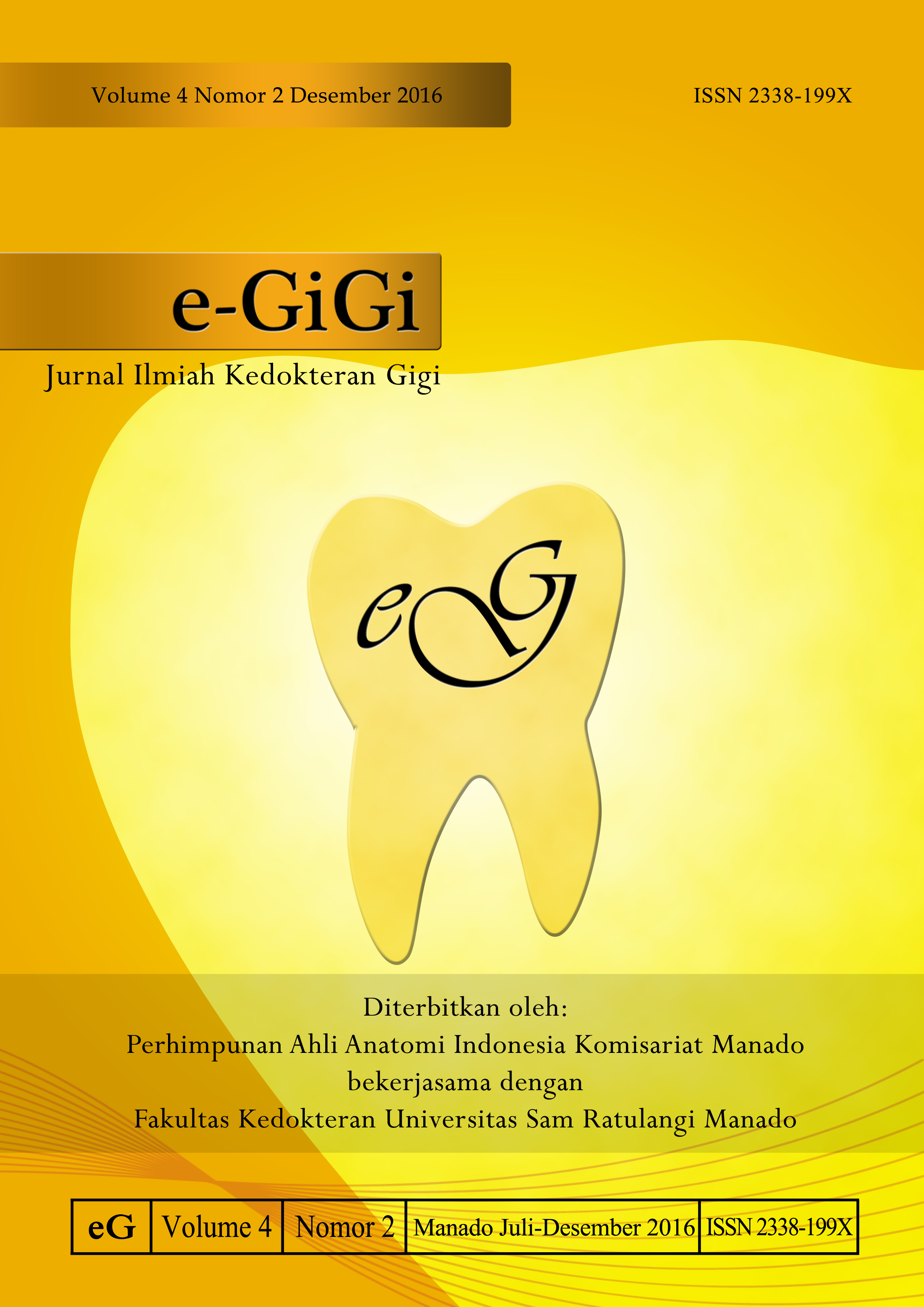Perbedaan efektivitas jus tomat (Lucopersicon esculentum Mill.) dan jus apel (Mallus sylvestris Mill.) sebagai bahan alami pemutih gigi
DOI:
https://doi.org/10.35790/eg.4.2.2016.13488Abstract
Abstract: Teeth appearance plays an important role in human interaction. One of its problems is tooth discoloration which can affect personal self confidence and appearance. Chemicals for whitening the teeth can cause negative effects such as decreased enamel hardness and gingival iritaion. An alternative material that can be used for that purpose is natural substance inter alia tomato juice (Lucopersicon esculentum Mill.) which contains hydrogen peroxide and apple juice (Mallus sylvestris Mill.) which contains malic acid. This study aimed to determine the difference in effectiveness of tomato juice and apple juice as natural bleaching agents. This was a true experimental study with a pretest postest only control group design. There were 30 samples of post-extraction anterior teeth soaked in coffee for 12 days and were further divided into 3 groups, each of 10 samples. Group 1 was immersed in tomato juice; group 2 was immersed in apple juice; and group 3 as the positive control was immersed in carbamide peroxide 10%. Each group was observed after 1 day, 3 days, and 5 days. The color change was measured by using CIEL*a*b method. The results showed that tomato juice, apple juice, and carbamide peroxide 10% could whiten the teeth. However, tomato juice was more effective compared to apple juice and carbamide peroxide 10%. Apple juice and carbamide peroxide 10% did not show any significant difference in color change.
Keywords: tomato juice, apple juice, carbamide peroxide 10%, tooth discoloration
Abstrak: Penampilan gigi berperan dalam interaksi manusia. Masalah dalam penampilan gigi salah satunya ialah perubahan warna gigi yang dapat memengaruhi kepercayaan diri dan keindahan penampilan seseorang. Penggunaan bahan kimia untuk memutihkan gigi dapat berdampak negatif seperti penurunan kekerasan email dan iritasi gingiva. Bahan alternatif yang dapat digunakan untuk memutihkan gigi yaitu dengan bahan alami antara lain jus tomat (Lucopersicon esculentum Mill.) yang mengandung hidrogen peroksida dan jus apel (Mallus sylvestris Mill.) yang mengandung asam malat. Penelitian ini bertujuan untuk mengetahui perbedaan efektivitas jus tomat dan jus apel sebagai bahan alami pemutih gigi. Terdapat 30 sampel gigi anterior pasca ekstraksi yang direndam kopi selama 12 hari. Sampel dibagi menjadi 3 kelompok masing-masing terdiri dari 10 sampel. Kelompok 1 direndam dalam jus tomat; kelompok 2 direndam dalam jus apel; dan kelompok 3 sebagai kontrol positif menggunakan karbamid peroksida 10%. Setiap kelompok dilakukan pengamatan 1 hari, 3 hari dan 5 hari. Perubahan warna diukur menggunakan metode CIEL*a*b. Hasil penelitian mendapatkan jus tomat, jus apel, dan karbamid peroksida 10% dapat memutihkan gigi. Jus tomat lebih efektif memutihkan gigi dibandingkan jus apel dan karbamid peroksida 10%. Jus apel dan karbamid peroksida 10% tidak memiliki perbedaan memutihkan gigi yang signifikan.
Kata kunci: jus tomat, jus apel, karbamid peroksida 10%, perubahan warna gigi
Downloads
How to Cite
Issue
Section
License
COPYRIGHT
Authors who publish with this journal agree to the following terms:
Authors hold their copyright and grant this journal the privilege of first publication, with the work simultaneously licensed under a Creative Commons Attribution License that permits others to impart the work with an acknowledgment of the work's origin and initial publication by this journal.
Authors can enter into separate or additional contractual arrangements for the non-exclusive distribution of the journal's published version of the work (for example, post it to an institutional repository or publish it in a book), with an acknowledgment of its underlying publication in this journal.
Authors are permitted and encouraged to post their work online (for example, in institutional repositories or on their website) as it can lead to productive exchanges, as well as earlier and greater citation of the published work (See The Effect of Open Access).






